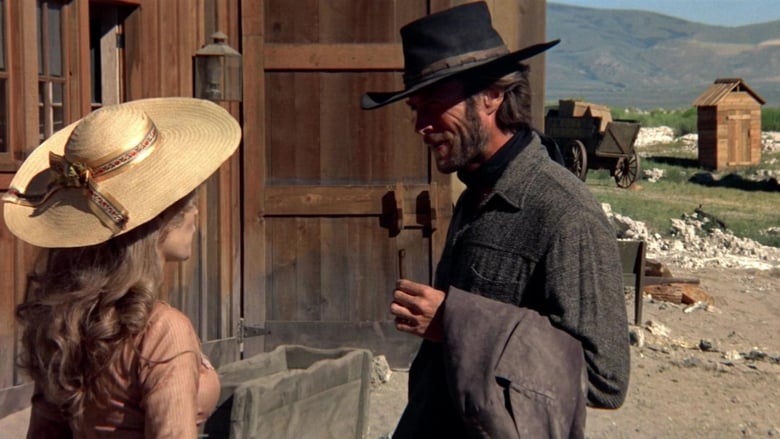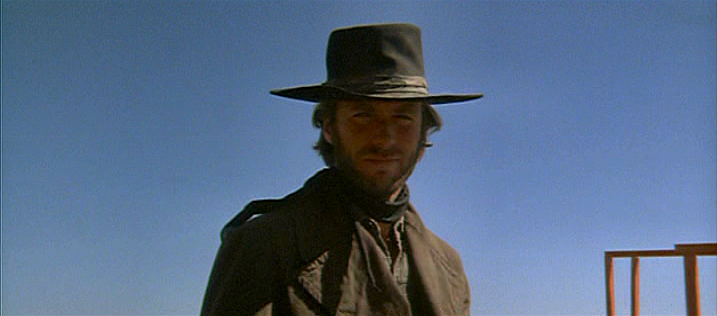← Back to Reviews

in
#725 - High Plains Drifter
Clint Eastwood, 1973

A nameless drifter arrives in a small town and is hired by the townspeople to defend them from a trio of bloodthirsty outlaws.
High Plains Drifter marks Clint Eastwood's second film as director and his first take on the Western, so naturally it serves as a deconstruction on par with other Westerns of the era. Much like the iconic roles he played in Sergio Leone's Dollars trilogy, Eastwood's protagonist is a nameless gunslinger who rides into a small frontier town; however, it's clear from the opening minutes that he's not even halfway heroic. Whether it's goading the local undesirables into attempting to kill him or even going so far as to rape the town prostitute (and then compound that by having her start to enjoy the act halfway through, which opens up a serious can of worms), it's clear that this is going to be one very unpleasant take on your typical Western narrative. Even the familiar-sounding plot about Eastwood being hired to help the townspeople defend themselves against a gang of recently-released bandits looking to take their revenge on the town is complicated in many notable ways. Leaving aside the incredibly murky sense of morality that Eastwood's character embodies, there's also the fact that the bulk of the townsfolk are extremely unsympathetic cowards; this much is borne out by their willingness to give Eastwood the run of the town simply for the sake of their own safety, which definitely comes back to bite them when he decides to milk that promise for all that it's worth.
Though it's arguably not quite as nuanced as it wants to be, High Plains Drifter proves a reasonably strong attempt at deconstructing the Western. While much of the film is as visceral as you'd expect from Eastwood, it does show some acid-like influences as it depicts dream-like flashbacks to a brutal whipping complete with eerie strings, to say nothing of the ways in which Eastwood's control of the town extends to surreal decisions such as appointing a little person to be the town's new sheriff or having every building in town be coated in red paint. It gets to the point where the actual outlaws who serve as the film's nominal villains become secondary to the points that the film attempts to make about the fickle morality of the townspeople, especially when it comes to pacing out the revelation of the town's dark secret. Such left-field revisionism is reflected on a technical level as the film uses some fairly disjointed camerawork and editing to effectively garnish Eastwood's usual levels of professionalism. While Eastwood would definitely go on to make better Westerns that mixed subversive nuance with classical technique, High Plains Drifter proves a reasonably strong way for him to begin, even if some parts are definitely up for debate.
Clint Eastwood, 1973

A nameless drifter arrives in a small town and is hired by the townspeople to defend them from a trio of bloodthirsty outlaws.
High Plains Drifter marks Clint Eastwood's second film as director and his first take on the Western, so naturally it serves as a deconstruction on par with other Westerns of the era. Much like the iconic roles he played in Sergio Leone's Dollars trilogy, Eastwood's protagonist is a nameless gunslinger who rides into a small frontier town; however, it's clear from the opening minutes that he's not even halfway heroic. Whether it's goading the local undesirables into attempting to kill him or even going so far as to rape the town prostitute (and then compound that by having her start to enjoy the act halfway through, which opens up a serious can of worms), it's clear that this is going to be one very unpleasant take on your typical Western narrative. Even the familiar-sounding plot about Eastwood being hired to help the townspeople defend themselves against a gang of recently-released bandits looking to take their revenge on the town is complicated in many notable ways. Leaving aside the incredibly murky sense of morality that Eastwood's character embodies, there's also the fact that the bulk of the townsfolk are extremely unsympathetic cowards; this much is borne out by their willingness to give Eastwood the run of the town simply for the sake of their own safety, which definitely comes back to bite them when he decides to milk that promise for all that it's worth.
Though it's arguably not quite as nuanced as it wants to be, High Plains Drifter proves a reasonably strong attempt at deconstructing the Western. While much of the film is as visceral as you'd expect from Eastwood, it does show some acid-like influences as it depicts dream-like flashbacks to a brutal whipping complete with eerie strings, to say nothing of the ways in which Eastwood's control of the town extends to surreal decisions such as appointing a little person to be the town's new sheriff or having every building in town be coated in red paint. It gets to the point where the actual outlaws who serve as the film's nominal villains become secondary to the points that the film attempts to make about the fickle morality of the townspeople, especially when it comes to pacing out the revelation of the town's dark secret. Such left-field revisionism is reflected on a technical level as the film uses some fairly disjointed camerawork and editing to effectively garnish Eastwood's usual levels of professionalism. While Eastwood would definitely go on to make better Westerns that mixed subversive nuance with classical technique, High Plains Drifter proves a reasonably strong way for him to begin, even if some parts are definitely up for debate.
